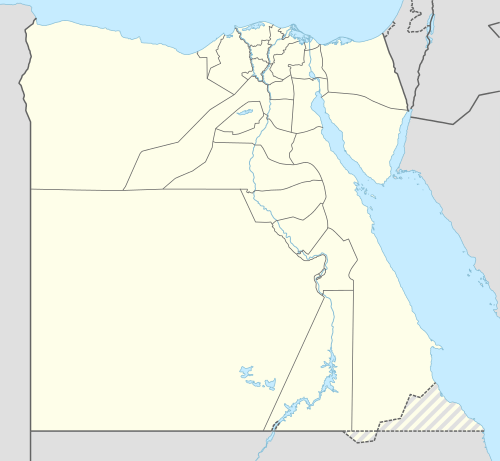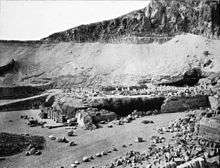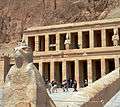Mortuary Temple of Hatshepsut
Coordinates: 25°44′18″N 32°36′24″E / 25.738266°N 32.606588°E
 Hatshepsut’s Temple | |
 Shown within Egypt | |
| Alternate name | Djeser-Djeseru |
|---|---|
| Location | Upper Egypt |
| Type | mortuary temple |
| Site notes | |
| Excavation dates | yes |
| Condition | Reconstructed |
The Mortuary Temple of Hatshepsut, also known as the Djeser-Djeseru ("Holy of Holies"), is an ancient funerary shrine in Upper Egypt. Dedicated to the Pharaoh Hatshepsut, it is located beneath the cliffs at Deir el Bahari, on the west bank of the Nile near the Valley of the Kings. The mortuary temple is dedicated to the sun god Amun and is situated next to the mortuary temple of Mentuhotep II, which served both as an inspiration, and later, a quarry. It is considered one of the "incomparable monuments of ancient Egypt."[1]
The Polish Academy of Sciences in Warsaw is responsible for the study and restoration of the three levels of the temple. As of early 1995, the first two levels were almost complete, and the top level was still under reconstruction.[2]
Architecture


Hatshepsut's chancellor, royal architect Senenmut oversaw construction.[3] Although the adjacent, earlier mortuary temple of Mentuhotep was used as a model, the two structures are nevertheless significantly different in many ways. Hatshepsut's temple employs a lengthy, colonnaded terrace that deviates from the centralised structure of Mentuhotep’s model – an anomaly that may be caused by the decentralized location of her burial chamber.[1] There are three layered terraces reaching 97 feet tall. Each story is articulated by a double colonnade of square piers, with the exception of the northwest corner of the central terrace, which employs Proto Doric columns to house the chapel. These terraces are connected by long ramps which were once surrounded by gardens with foreign plants including frankincense and myrrh trees.[3] The layering of Hatshepsut's temple corresponds with the classical Theban form, employing pylons, courts, hypostyle hall, sun court, chapel and sanctuary.

Relief and sculpture
The relief sculpture within Hatshepsut’s temple recites the tale of the divine birth of a female pharaoh – the first of its kind. The text and pictorial cycle also tell of an expedition to the Land of Punt, an exotic country on the Red Sea coast. While the statues and ornamentation have since been stolen or destroyed, the temple once was home to two statues of Osiris, a sphinx avenue as well as many sculptures of the Queen in different attitudes – standing, sitting, or kneeling. Many of these portraits were destroyed at the order of her stepson Thutmose III after her death.
Astronomical alignment

The main and axis of the temple is set to an azimuth of about 116½° and is aligned to the winter solstice sunrise,[4] which in our modern era occurs around the 21st or 22 December each year. The sunlight penetrates through to the rear wall of the chapel, before moving to the right to highlight one of the Osiris statutes that stand on either side of the doorway to the 2nd chamber.[4] A further subtlety to this main alignment is created by a light-box, which shows a block of sunlight that slowly moves from the central axis of the temple to first illuminate the god Amen-Ra to then shining on the kneeling figure of Thutmose III before finally illuminating the Nile god Hapi.[4] Additionally, because of the heightened angle of the sun, around 41 days on either side of the solstice, sunlight is able to penetrate via a secondary light-box through to the innermost chamber.[4] This inner-most chapel was renewed and expanded in the Ptolemaic era and has cult references to Imhotep the builder of Djoser's Step Pyramid and Amenhotep son of Hapu - the overseer of the works of Amenhotep III.[5]
Historical influence
Hatshepsut’s temple is considered the closest Egypt came to Classical architecture.[1] Representative of New Kingdom funerary architecture, it both aggrandizes the pharaoh and includes sanctuaries to honor the gods relevant to her afterlife.[6] This marks a turning point in the architecture of Ancient Egypt, which forsook the megalithic geometry of the Old Kingdom for a temple which allowed for active worship, requiring the presence of participants to create the majesty. The linear axiality of Hatshepsut’s temple is mirrored in the later New Kingdom temples. The architecture of the original temple has been considerably altered as a result of misguided reconstruction in the early twentieth century AD.
Gallery
 Temple of Hatshepsut
Temple of Hatshepsut Deir el Bahari
Deir el Bahari Temple of Hatshepsut
Temple of Hatshepsut- Hatshepsut Temple
- Hatshepsut Temple
.jpg) Hatshepsut Temple
Hatshepsut Temple- Tempio di Hatshepsut
- Deir el-Bahari TIII
 Mortuary Temple of Hatshepsut, detail
Mortuary Temple of Hatshepsut, detail Mortuary Temple of Hatshepsut, detail
Mortuary Temple of Hatshepsut, detail Mortuary Temple of Hatshepsut, detail
Mortuary Temple of Hatshepsut, detail Mortuary Temple of Hatshepsut, detail
Mortuary Temple of Hatshepsut, detail Mortuary Temple of Hatshepsut, detail
Mortuary Temple of Hatshepsut, detail Mortuary Temple of Hatshepsut, Column detail
Mortuary Temple of Hatshepsut, Column detail Mortuary Temple of Hatshepsut, Column detail
Mortuary Temple of Hatshepsut, Column detail Mortuary Temple of Hatshepsut, detail
Mortuary Temple of Hatshepsut, detail Mortuary Temple of Hatshepsut, detail
Mortuary Temple of Hatshepsut, detail Mortuary Temple of Hatshepsut, detail
Mortuary Temple of Hatshepsut, detail Mortuary Temple of Hatshepsut, Column detail
Mortuary Temple of Hatshepsut, Column detail
See also
Notes
- 1 2 3 Trachtenberg & Hyman 2003, p. 71
- ↑ Archived March 14, 2015, at the Wayback Machine.
- 1 2 Kleiner 2006, p. 56
- 1 2 3 4 Furlong, David Winter Solstice Alignment at Deir El Bahari – Photographic evidence of the winter solstitial alignment
- ↑ Wilkinson 2000, p. 178
- ↑ Strudwick & Strudwick 1999, p. 80
References
- Kleiner, Fred S. (2006). Gardner's Art Through the Ages: The Western Perspective Volume I (12th ed.). Victoria: Cengage Learning. p. 56. ISBN 0495573604.
- Strudwick, Nigel; Strudwick, Helen (1999). Thebes in Egypt: A Guide to the Tombs and Temples of Ancient Luxor (1. publ. ed.). Ithaca, NY: Cornell Univ. Press. ISBN 0-8014-3693-1.
- Trachtenberg, Marvin; Hyman, Isabelle (2003). Architecture, from Prehistory to Postmodernity. Italy: Prentice-Hall Inc. ISBN 978-0-8109-0607-5.
- Wilkinson, Richard (2000). The Complete Temples of Ancient Egypt. United Kingdom: Thames and Hudson. ISBN 0-500-05100-3.
External links
- Hatshepsut: from Queen to Pharaoh, an exhibition catalog from The Metropolitan Museum of Art (fully available online as PDF), which contains material on Mortuary Temple of Hatshepsut (see index)
- Temple of Hatshepsut free high resolution images
- Temple of Hatshepsut layout illustration
- Polish-Egyptian Mission working in the Temple of Hatshepsut at Deir el-Bahari